 |
 |
 |
 |
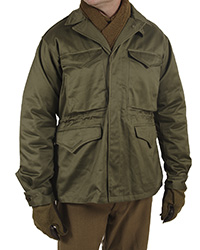
370D M1943 Field Jacket,
Pattern B |
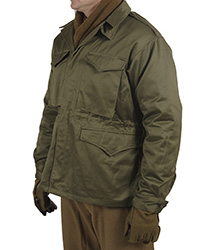
Full cut to allow room
for liner and uniform
underneath |
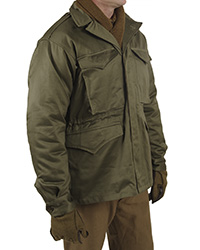
Model is 5'11", 175lbs, wearing
a 40R/ M Jacket with a liner,
shirt and sweater underneath
|
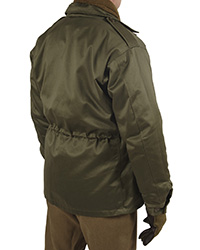
|
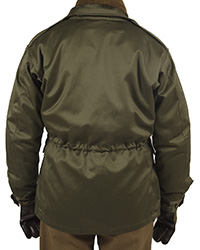
Rear view
|
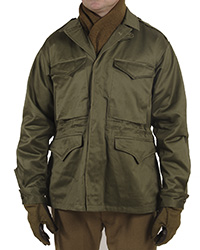
|
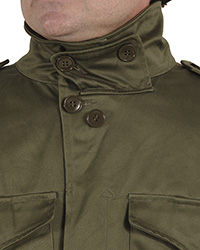
Neck flap.
|
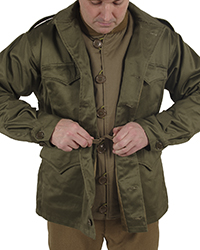
Waist tie
|
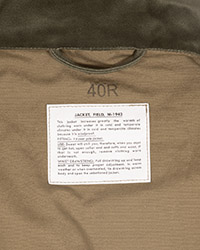
Instruction label peculiar
to 370D
|
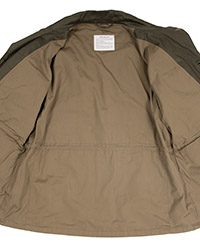
OD3 lining- used on some 370D's.
(Others used the darker OD7.)
|
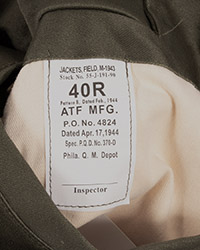
Spec labels.
|
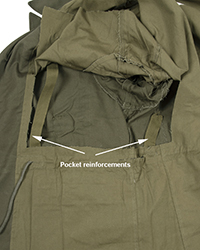
Cut away showing
webbing reinforcements
for hip pockets.
|
|
|
|
|
Reproduction of the "Pattern B" model of the M1943 Field Jacket worn by US troops toward the end of WWII. During the War, there were
three versions of the new field jackets manufactured which can be identified by
their specification numbers- 370B, 370C, and 370D.
The 370B's and approximately
half of the 370C series were fitted more closely than later jackets. Although
this gives a better appearance, it made them tight when the pile liners were worn
underneath.
So, mid-way through the 370C contracts, the
Quartermaster issued an amendment to the pattern known as "Pattern
B". This added 2" to the chest measure and about 1" to the upper
arm circumference which gave a more comfortable fit when wearing extra layers
underneath, as well as a baggier, sack-like appearance.
The pattern B design
was retained for all future production of the Field Jacket, up to and including
the "M65" still produced today.
Click here for more information on M1943 Field Jackets.
ATF's Pattern B Jackets: We chose to reproduction the third WWII variant, the 370D. This specification was issued in February, 1944 and production began in April, leaving plenty of time for them to arrive in the ETO by September for Operation Market Garden. These jackets are identical to the previous 370C Pattern B's aside from the large instruction label in the neck. Customers love the "cool" label and it makes it very easy to distinguish these from our early production jackets.
For our jackets we only original, unmodified examples for the pattern, proportions and all details. Buttons, ties, and labels are all correct. The fabric even has the sheen common to many unissued originals (it actually depends on which side of the fabric was facing outward) which will gradually dull with use.
The shell fabric is 100% cotton 8 oz. sateen fabric in Olive Drab #7 shade. It has been treated with PFOA free Teflon fabric protectant which provides an invisible, water repellent finish that does not affect the feel of the fabric. The lining is a lighter OD shade of cotton poplin as many 370D's were lined with left over M41 jacket fabric.
Like the originals, the hip pockets are made with two layers of cotton twill, and the corners of the pockets are reinforced with 3/4" webbing attached to the side seams of the jacket. (See pic above.)
The instruction and spec labels are correctly copied down to the QMC stock numbers.
Issue: The 3rd Infantry serving in Italy was the first unit to receive M43 Field Jackets in late 1943-early 1944. Troops in the ETO did not receive them (due to interference from Eisenhower) until September with the airborne units going into Holland. Infantry and armored divisions began receiving them in the Fall, but they didn't become commonplace until 1945. It appears that units already in the ETO were often the last to receive them.
Insignia: Yes and no- both are correct. Wartime photos show plenty of examples of jackets being worn with unit and rank patches as well as with nothing. It's best to research the specific unit for the answer.
Fit: The US Army specifically designed the M1943 Field Uniform as a layered system. Therefore, the Pattern B jackets are intentionally loose fitting and baggy to allow room for multiple layers of clothing underneath. Multiple general officers during WWII complained about its "unmilitary appearance" and several managed to delay production for this reason.
Care: We recommend cold wash/ hang dry for longest life and least fade.
Imported
|
|
 |
 |
 |
 |

|